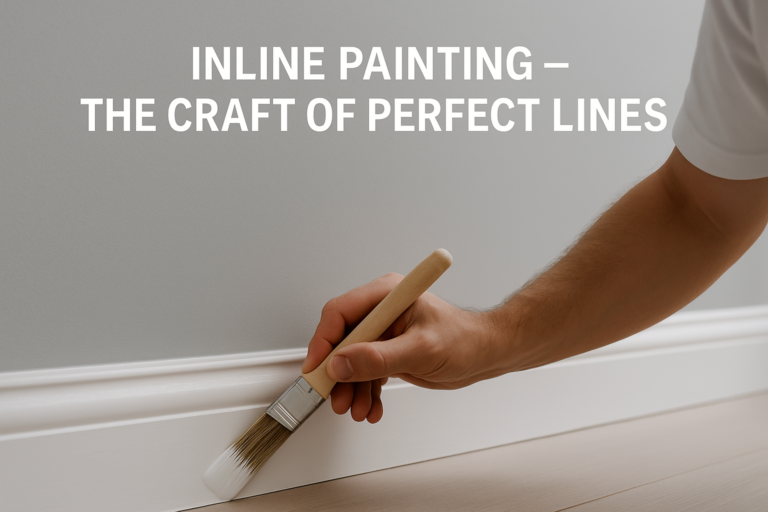Inline painting – the craft of perfect lines that elevate an entire room
You don’t have to be a decorator to feel when something’s not right in a freshly painted room. Most people can’t name the issue—but their eyes land exactly where they shouldn’t: at the base of the wall, on the skirting, or up where ceiling meets wall. A shaky line. A corner with a fuzzy edge. And suddenly, everything feels… unfinished.
That’s where inline painting steps in.
what is inline painting – and why it matters more than most think
You won’t hear the term in shops or see it printed in paint brochures. But inline painting is what separates a quick job from a finished space. It’s the detail that makes a room feel right, even if you don’t know why.
Inline painting means drawing clean, straight, confident lines where two surfaces meet—walls and skirting, ceilings and walls, frames and plaster. It’s about discipline, not speed. It’s about doing things properly, even when nobody notices.

painting brings balance to a room
One client in Lucan said something that stuck with me:
“I didn’t even know that part of the wall could look that neat—it makes the rest of the house feel new.”
He wasn’t talking about the paint colour. He was talking about the line between the wall and the top of the skirting. When that line is crisp, everything else just falls into place.
the technique – it’s about more than masking tape
Masking tape can help. But it’s not the main player.
- the brush matters – we use 1-inch angled sash brushes with clean, firm bristles. A cheap brush won’t do.
- light is key – natural light only. no yellow bulbs. no evening rush. we paint when the room tells the truth.
- steady hand, anchored arm – it’s not a stroke, it’s a signature. you move slowly and breathe with it.
- no shortcuts – inline painting comes last, when the rest is done and dry. it’s the quiet detail that finishes the space.
where inline painting shows its power
- skirting boards – where the wall meets the top edge, perfectly aligned, no bleed, no fluff.
- corners and junctions – where two colours meet, and the margin is unforgiving.
- around switches and sockets – those tight spaces where most brush marks hide.
Inline painting makes these areas seamless. Clean. Proper.
common mistakes to avoid
- over-relying on tape – left on too long or peeled too fast, it lifts paint and wrecks your edge.
- poor brushes – they shed, they drag, and they leave behind more mess than they fix.
- bad timing – painting too soon over a base coat that hasn’t cured? your clean line won’t last.
We avoid all of that. Not because it’s easy, but because the end result is worth it.
why clients care – even if they don’t know it
When a room is freshly painted, people don’t say, “Wow, look at that perfect ceiling line.” But they feel it.
Good lines bring calm. They make a space feel fresh, finished, intentional. That’s what clients respond to—even if they can’t put it into words.
It’s the difference between “that’s grand” and “this feels right.”
final thoughts – where you draw the line is where quality shows
Inline painting might go unnoticed—but it’s what separates a decent job from a space that feels new. It’s where the standard lives. And when it’s done right, you won’t notice the line at all.
But you will feel the difference.
If that sounds like the kind of job you’re after, give us a call.
Good lines don’t paint themselves.
